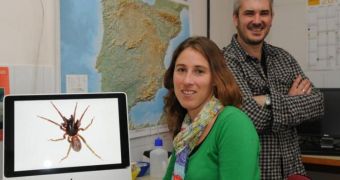Investigators at the University of Barcelona, in Spain, say that the collision which occurred between the African and Eurasian tectonic plates – some 30 million years ago - opened up the Mediterranean Basin, but also drove a boost in the diversity of spider species living in the area.
The tectonic event primarily affected an endemic group of Western Mediterranean spiders, which expanded by a wide margin during that interval. The new research was carried out by experts Miquel A. Arnedo and Leticia Bidegaray-Batista.
Both are based at the UB Department of Animal Biology, and at the university's Biodiversity Research Institute (IRBio). Details of their study appear in the latest issue of the scientific journal BMC Evolutionary Biology.
Usually, evolutionary biologists say, tectonic activities only have indirect, slow-acting effects on local fauna and flora, primarily because the changes occur over millions of years. When viewed from our vantage point, the phenomena appear brief but, to species living at the time, they took forever.
As such, “this is the first scientific work that proves that such an important tectonic event in the Mediterranean had a relevant impact on the diversification of the local fauna,” explains Arnedo. The expert leads the UB Arthropod, Systematic and Evolution Laboratory.
He and his colleagues focused their research on the spider genus Parachtes, which are nocturnal arthropods that spend their time during the day by nestling in their cocoons. They can be found throughout the Balearic Islands, Corsica, Sardinia and the Iberian and Italic peninsulas.
“So far it was assumed that the tectonic collision of the African and Eurasian plates originated the diversification of the fauna endemic to the Western Mediterranean. Nonetheless, no scientific study had confirmed that possibility,” says Bidegaray-Batista, the first author of the study.
“With this research, we prove for the first time that the distribution of the genus Parachtes is linked to the tectonic events that occurred in the Mediterranean more than 25 million years ago,” she adds.
Studies such as this one are possible throughout the world, but investigators need to keep a close eye out on what they are trying to find. Jumping to the wrong conclusions is very easy in such researches, AlphaGalileo reports.

 14 DAY TRIAL //
14 DAY TRIAL //